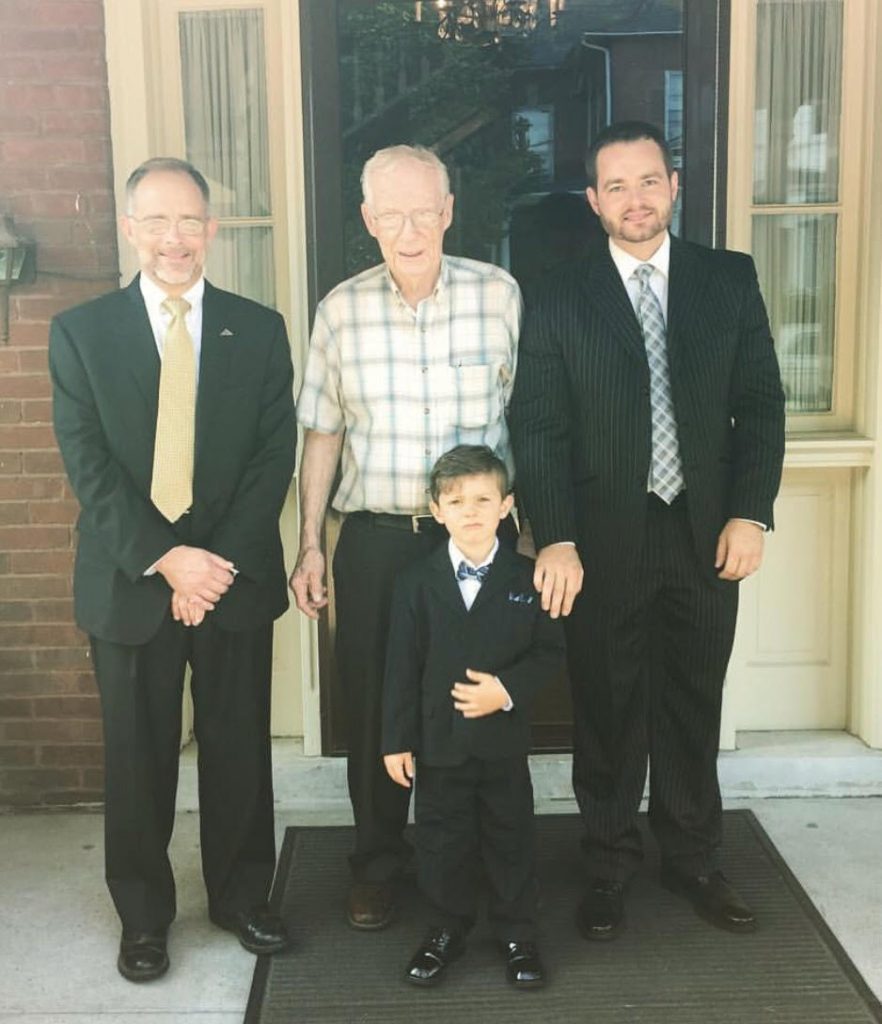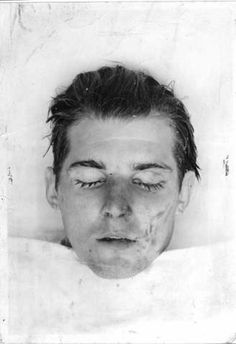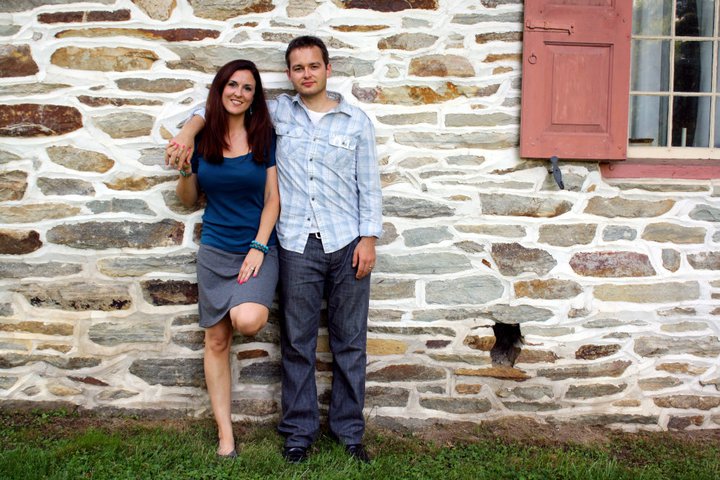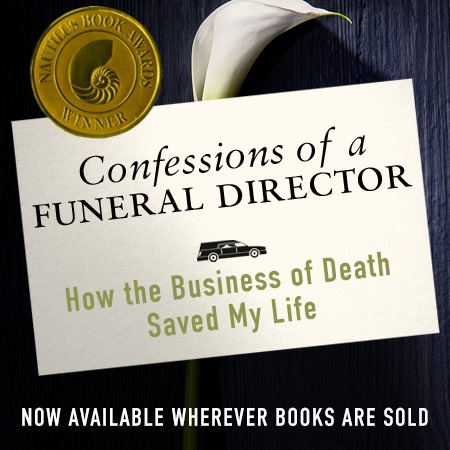Death
10 Ways Working in Death Care Affects Me as a Parent
 Bad Table Manner Teacher
Bad Table Manner Teacher
It was passed down to me by my father, and down to him from his father. When you work with death, you talk about death, even around dinner. That’s all fine and good if it stays in-house, but when Jeremiah goes on his first date and starts rattling off what his dad does for a living, it might hurt his chances for a second date.
More Cautious
“Remember to wear your bicycle helmet because I buried a kid that didn’t!”
“No, that seat belt needs to be across your chest. I don’t want you to be launched through the windshield like Billy Johnson.”
“There’s a reason I want you to chew your food. Because if you’re ever eating alone and you choke, well ….”
“Never underestimate the power of an angry beaver.”
It’s easier to switch off work
You think it’d be the opposite. I mean, going from wrestling a dead body onto an embalming table to wrestling your son an hour later is a little outside the norm.. For me, being around death helps me value every moment I get with Jeremiah. Death makes me love his life.
Funeral Suits. The children of funeral directors have funeral suits.
Because we’re not afraid to send our kids to funerals. And we also want them to look sharp doing it.
Dead Bodies are No Big Thing
I don’t remember the first time I saw a dead body, and neither will Jeremiah … because they’ve just been a natural part of our lives since as long as we can remember.
Dead Children are a Bigger Thing
Any death care worker has seen their share of the unspeakable. It affects all of us. Whenever we have to serve a family that lost a child, everyone at the funeral home is moody, on edge and generally not pleasant. It’s hard enough as is, but when you see YOUR child in the face of the little one in your prep room, it drives it home even deeper. This is the stuff of literal nightmares.
LOVE YOUR ELDERS
It’s probably because I model it to him. If you work in the funeral business, you naturally work with people who are older. As kids, we’re taught to respect your elders. As we age, that respect turns to love because the older they come, the better they are (for the most part). Jeremiah sees my love (and respect) for the elderly and he mimics it. I love that.
Spoiler Spoiler
If I’ve seen a movie or show before someone else, I usually make the spoiler joke that “everyone dies at the end” because I’m a funeral director it’s a nice double entendre. But, in Infinity Wars, that joke is only half true. Whoops. Sorry.
Don’t you hate spoilers? Working in the funeral business is one big spoiler because the dead love to remind you about the ending of your story.
Enter children with all their life, all their hope, trust, and carefree resilience. All that, all that they are, has a way of spoiling the power of the spoiler. Because some narratives are so good, you can thoroughly enjoy the story even when you know how it ends.
Missing Events
Like every parent, we try our best to be at their sports games and stuff happens. When we’re on call, nothing is sacred, including time with the kids.
Pursue your dreams, kid and I’ll celebrate your every step.
We’ve all been hammered with these little truisms like, “live so you don’t have regrets on your deathbed”, and “live like you’re dying”, and, #YOLO. For those of us who are close to death, truisms have been hammered home much deeper.
Often, though, we use those truisms for ourselves, and our dreams, and our careers, but the profound thing that death has taught me is that the best life I can live is when I’m celebrating someone else. That someone else, for me, is Jeremiah.
*****
If you like my writing, consider buying my 2017 Nautilus Book Award Gold Winner, Confession of a Funeral Director (click the image to go to the Amazon page):
What It’s Like Embalming a Child Killed by Gun Violence

Another school shooting. Ten people died, nine students. This is the 22nd school shooting since the beginning of 2018. The 22nd in just over five months. Let that sink in.
At this point, we’re tired of it, tired of it happening, tired of hearing about it, and tired of the polemics. So maybe a perspective from a funeral director and embalmer can help scratch off the callous. As a forewarning, the content in this post will be disturbing as I present the problems embalmers face with gun wounds.
I was told in funeral school that funeral directors should never, under any circumstances, divulge their political opinions. “Unless you want to lose business,” my prof told us during the fall of 2004 when the Kerry Vs. Bush political battles were headlining, “keep your politics out of death care. Death is about unity, goodwill, and grace. Politics is the exact opposite.”
My prof was right on both accounts. I write in my book how death allows us to transcend our little groups and see the bigger picture, namely that at our core, we may be Democrat or Republican, black or white, gay or straight, but we’re also fundamentally human. Our distinctives are important and should never be minimized, but death gives us a little reprieve from the unneeded tension because it allows us to focus on the things that bind us together, not the things that divide us. Remember 9/11? Remember how we joined together for a month or so, united?
There’s a time for political action, and as I’ve argued before … if grief is the basis for someone’s action, it’s not our job to lecture that activist because — although death can be a classroom — you are NEVER the teacher. Simply: our job as outsiders is to give the grieving a refuge, not put them in a classroom.
While funeral directors rarely get political, that doesn’t mean we don’t get involved. Seventy-one-year-old Ronald Jones, a funeral director from St. Louis was tired of burying kids killed by gun violence, so he finds at-risk youth on the streets and mentors them.
This from an interview with Mr. Jones, a piece that captures what funeral directors experience when a death is by gun violence and the family wants some restoration:
Many times Jones said he’s recognized people that he’s cared about come across his (prep room) table. Nearly seven years ago, he lost someone that he had mentored for years. To this day, Jones still refers to her as one of his “kids.” She was shot 11 times. The bullet wounds left her face mutilated and her skull shattered. When he saw her, Jones didn’t even recognize her.
It took him a few days just to sew up all of the entrance and exit wounds to her face, and he had to use 254 pieces of wire to reconstruct her skull. But as he got closer to making her whole again, things started to become a lot clearer.“When I pulled the face over the skull, I almost fell out on the floor, because I’m recognizing somebody that I know and was dear to me,” Jones said. “So I was mandated to really do my best to bring her back so her baby and aunt who raised her could bring some closure.”
Even though funeral directors are rarely political, we often see the outcome of violence, on both a physical and psychological level. We put together faces, and we attempt to put together the funerals for those faces. Seeing that, touching that, stitching that back together … it does something to a person. I can’t exactly say what it does except that it makes the world’s problems seem so much larger and so much more difficult.
What is it like putting faces back together? Well, it depends.
Either today or tomorrow, the parents and the families of the Santa Fe shooting victims have to make this decision: do we want to have a public viewing for our daughter/son’s body, or not?
As the details of the shooting were coming out, I was particularly struck by the fact that the Santa Fe High School shooter used a handgun and a shotgun. From a number of accounts, it seems the shotgun was his weapon of choice. If so — like an assault rifle as well — a shotgun can create a variety of difficulties for an embalmer trying to restore the child.
If I’m a parent, and a public viewing with embalming/restoration is something I want, I’m hoping that my child was one of the ones killed by a handgun (the shooter used a .38 revolver).
I’ve buried a number of people who died from both shotgun wounds and handgun wounds, and there are three general categories of possibilities for a death by firearm, and some different embalming methods we’d likely have to use for each. One or more of these methods would need to be employed for any child shot in a school shooting:
One: SHOT TO THE HEAD: A handgun will have a small entry point and a slightly larger exit point (assuming it exits the body). A person can shoot themselves point blank in the skull and most of the time, the entry point is a little smaller than a penny. That’s usually a simple job for us to fix. Some basic cosmetology and you can hardly tell where the bullet entered.
A shotgun is completely different. Depending on how close the shooter is to their target, a shotgun spray can disfigure a person’s body, especially the face.
Assuming the family wants to see the body, funeral directors have to be honest with ourselves, “Can we reconstruct the severe trauma? Can we make this look somewhat normal?” If the facial features have been ripped off, usually the answer is “no.”
If the shot was to the back of the head, the skull is likely fragmented, but as long as the spray didn’t exit through the front of the face, we can piece the skull back together, or reconstruct the skull through a variety of options.
Two: BODY SHOT: No biggie. A body shot might damage the arterial system, but it’s unlikely that it’d do any more damage than an autopsy, which is something embalmers encounter on a regular basis. In fact, many states require a full autopsy for any suspected homicide, which would mean the heart — the center for arterial distribution of the embalming fluid — would likely be removed for examination. Multi-point injections are a rather regular occurrence for embalmers. A body shot is the best case scenario if the family wants their child to have a public viewing.
Three: MULTIPLE SHOTS TO HEAD AND BODY: If the head and body have sustained multiple shots, the embalming process is much more complex as we have to raise injection sites on the body for specific locations. In Sandy Hook and Parkland, Flordia, the shooters used assault rifles, which resulted in many of the victims being shot numerous times with higher velocity bullets. Multiple shots from an assault rifle, depending on where they hit and what caliber bullet can cause significant trauma to the head and body, making embalming and restoration much more technical, if not impossible.
If the parents want their child embalmed for a viewing, it falls on us to do our best, and be honest with the family if it’s an impossibility. Some embalmers will be putting countless hours into restoration to make the Santa Fe children look as much like they did before they got shot at their school.
And when all is said and done, the best job they can do might still not be perfect. But this is violence, this is a tragedy and perfect disappeared as soon as the shooter starting pulling the trigger.
At this point, most articles about school shootings end with an action point or a political sound byte. I’m a funeral director and embalmer. I’m not supposed to get political. I can’t tell you how to fix the problem, all I can say is that I wish we never had to fix the fractured faces and bodies of school children. I wish we never had to hear mothers and father weep. I wish we never had to … but we do.
*****
If you like my writing, consider buying my 2017 Nautilus Book Award Gold Winner, Confession of a Funeral Director (click the image to go to the Amazon page):
10 Things about Funeral Director’s Love Lives

I know what you’re thinking. “Caleb, you’re reaching on this one. You’re just looking to write a post that lets you pluck the low hanging jokes, like ‘Funeral directors can make you stiff’, etc.” You got me there. I tend to pick the easy jokes, but bear with me because this is a thing, a thing that NOBODY TALKS ABOUT.
Because when you work in a profession that sees nearly 80% of their workforce burn out before they hit the five-year mark of employment, you can bet that their love lives are a little different than most.
One. Commitment confusion.
This job asks us to marry it. It asks for us in sickness and in health, night and day, in good times and bad. Death is always asking, always needy, always calling and texting. It’s tempting too, because when we can fulfill the needs of death, it can create a kind of co-dependent relationship where we fulfill the needs of death and death fulfills our needs of feeling important. When death is so demanding, all other relationships become mistresses.
Two. Good back rubs.
It’s very true. We give very good backrubs. And the fact that we give good backrubs has nothing to do with the fact that we’re constantly massaging the dead to make sure the embalming fluid get’s evenly distributed throughout the decedent’s corpse.
Three. Bi-polar Sex Drive.
The Jekyll and Hyde Syndrome also affects our physical relationships with our partners. This is real. And surprisingly, the show Six Feet Under captured this well in the complexity of their characters. For all of us, our sex drive can be seemingly unpredictable. For those who work around trauma, death, and grief, those drives seem to go to utter extremes. Because sex — for some — is a natural stress diffuser, and when we’re under professional stress on a constant basis, our desire for that physical relief can — at times — be overwhelmingly strong. Other times, that stress is so overwhelming we don’t even want to be touched.
Four. General Audio Illusions
Funeral Director Dude (while having sex): Oh, Laurel! I love you so much!
Laurel: WHO THE HELL IS ‘YANNY?!’
I suppose we all suffer from that problem.
Five. On Children
After a bad day at work: “I don’t think we should have children. This world is too dark and scary.”
After a good day at work: “WE SHOULD HAVE CHILDREN RIGHT NOW!!!”
Six. Transference
Transference is a psychological term that funeral directors have some practical experience dealing with. Some people we deal with have major problems and baggage that gets fanned to flame by grief and bereavement. Often times, they take their problems, their anger, their frustration and instead of dealing with their grief and bereavement, they take it out on us. If you’ve been in the business long enough, you know not to take it personally, but it’s nonetheless difficult to take a capricious verbal lashing for no apparent reason other than transference.
But here’s how it affects relationships: funeral directors too often do the same, especially to their significant others. See, generally, we take out our problems on those we see as our equals or those we see as inferior. While I hope nobody is in a relationship with someone who views them as inferior, most of us tend to be in relationships with people we perceive as equals. So that stress, baggage, angst that we pick up in the funeral business often gets taken out on those closest to us in our personal lives.
Seven. Bringing our Work Home
Most jobs can be left at work. But there’s so much personal stuff with the funeral business, so much stuff that affects US, that it’s almost impossible to leave things there. It also doesn’t help that there are still many family-run funeral homes that literally have their home on the second floor of the funeral home. Work is literally one flight of steps away from everything.
Eight. Flowers.
We’ll always give you flowers. Endless flowers. Forever. Mind you, they’re likely left over funeral flowers, but still.
Nine. The Chaotic Schedule
If funeral directors are going to have love lives at all, there has to be an understanding: when we’re on call, nothing is safe and nothing is sacred. We could be at a fancy dinner and our phone rings and we have to go. Watching Netflix, phone rings and we have to go. Sex, phone rings, go quickly then go.
Ten. The Jekyll and Hyde Syndrome.
Okay. I’m making this syndrome up. Nevertheless, it describes how the funeral business makes you feel. Here’s a brief 10-day snapshot of how quickly certain deaths and certain funerals can change us:
DAY 1: We come home from the funeral home and we’re serious and philosophical, contemplating the meaning of life. “Babe, I think we need to pursue our dreams and hug each other more often BECAUSE WE ONLY GOT ONE LIFE!”
DAY 2: The next day, we come home after having dealt with some tragic death and we’re like, “Babe, life’s meaningless … maybe we should just get drunk every night.”
DAY 3: “Lovie, I think we need to up our commitment to God and the church because this family I served today … there’s so much good in faith!”
DAY 4: After a bad experience with a pastor, “Lovie, let me tell you: religion is horrible. These people. Ugh. So. Much. Fake.”
DAY 5: We want to tell you everything, from the removal to the embalming, to the sights and the sounds. We chatterbox on and on for hours about our day.
DAY 6: “Snuggie Woogems, I DON’T WANT TO TALK. JUST LEAVE ME ALONE.”
DAY 7: “Jelly Bean, I think we should be saving more for retirement ’cause I met with this older couple who have nothing.”
DAY 8: After getting a death call for a young person: “Jelly Bean, let’s spend it all. What makes you happy? Shoes? Let’s buy all the shoes … because we could die tomorrow.”
DAY 9: “I’m on a diet today, Chipmunk. I want to age as best as I can. Quality of life, Chipmunk. Quality of life. Also, we need to join the gym.”
DAY 10: *Stress eats an entire pizza and sleeps for 14 hours*
DAY 11: “I know my job’s hard, Love Muffin, but at least we have an income.”
DAY 12: After a 12 hour day on what was supposed to be a day off, “I’m quitting, Love Muffin. Time to downsize.”
One day, we’re one person and the next day we’re a completely different person because when you attend to the dead and their funerals on a daily basis, the lives of the people you serve tend to change you, shape you, challenge, stretch, anger, encourage and confuse you all at once, all the while confusing your partner to no end. You just have to hope your partner loves your chaos.
*****
If you like my writing, consider buying my 2017 Nautilus Book Award Gold Winner, Confession of a Funeral Director (click the image to go to the Amazon page):
On Death and Humor, and White House aide Kelly Sadler joking about John McCain’s Death

Imagine you’re a neanderthal. You’ve yet to develop language, and your other communication skills are pretty primitive. Now imagine you’re hunting in the woods with your Winchester Model 70 Featherweight (they had those back then).
All of a sudden you bump into something and your “fight or flight response” is activated. Should I point my gun at whatever this thing is, or should I run away, yelling at the top of my lungs? It turns out, that the thing you bumped into is, in fact, another neandertal from another part of the city (those were a thing too). You point your gun (because that’s your first reflex) and they other neanderthal points his at you. You can’t speak, but instead of shooting each other you break out into laughter. Because laughter has always been a way to disengage the fight or flight response, and it’s thought to predate language. Laughter calms things down. It’s an actual scientific factoid.
It even calms things down around death and dying, which is why you’ll often hear jokes and laughter at funerals, or in other death situations. It helps calm the mind from fear, grief and other things that cloud our thinking when we’re confronted with the reality of mortality.
*****
A couple months ago we had a death call at a person’s home. We got there and there was tension in the air. One side of the family was in the house with the decedent, while the other side had been forced outside of the house. The family inside had four bodyguards standing at the door in case the outsiders tried to go in and see the deceased one last time.
When I got inside the house, I was asked — because apparently, I look both nice and stupid — if I could go outside and try to calm the outsiders down. I told the family inside the house that I’d do it if they allowed those outside the house to view the deceased as I removed her out to our van.
“Fine,” they said.
I went outside and brokered the deal: you guys outside can view the deceased when I take her out of the house just as long as you don’t try to force yourselves into the house.
“Deal,” they said.
When I came back inside, the family asked me if they agreed to the terms.
I looked the husband in the eye and told him we solidified the deal by drinking a round of Jack Daniels.
It really wasn’t a funny joke. But because our brains crave the calm of a good laugh when things are stressful, the whole room erupted in laughter. The tension broke. Instead of anger, there were tears. And instead of fighting, even a hug.
Is a joke really that powerful?
Yes. Yes, it can be.
And that power can go both ways. A well-timed, well-intentioned joke can, in the right circumstances, can be a force for good.
In other circumstances, it can do the exact opposite. This is the case for Kelly Sadler.
*****
Here’s the low-down if you haven’t been following the news. I should note that her comment has been hedged by calling it an in-the-moment joke:
Kelly Sadler, a communications aide in President Trump’s administration, reportedly said during a meeting Thursday that Sen. John McCain’s opposition to CIA nominee Gina Haspel “doesn’t matter” because “he’s dying anyway.”
I started to pay rather close attention to politics around Clinton’s second term. By the time Bush v Gore rolled around, I was hooked on the political soap opera. For about five years I studied political theory in my spare time, browsing through the old stuff from The Federalist Papers to Locke’s work, and even writing about it (essays that I would never, ever share publically). Today, I stay up-to-date on the political world, have my opinions, but generally stay away from the fray.
Politics have been tense for as long as I’ve known them. But they’ve never been tenser (and yes, I looked it up … it’s “tenser” and not “more tense”) than they are right now. It’s. Hot. No two words in America (and maybe even the world) are more divisive than “Donald” and “Trump.” For those who support him and those who don’t, those words have separated friends, families, and neighbors in the real world. There are a lot of thoughts and feelings. In the world of social media, both sides of the political spectrum have objectified the “other side” to the place that we no longer view “them” as people, but as “enemies of the American way.”
I used to think funeral homes held a lot of tension, but there’s clearly another house on 1600 Pennsylvania Ave. that holds more. Kelly Sadler works there. She’s staff there. I know what it’s like to work in a tense environment.
Let me be clear, there’s nothing wrong with making jokes about mortality. Everyone in my family jokes about their own and each other’s mortality. Even my grandfather — who is likely closest to his end in our family — gives and receives some funny lines about his future.
But, there are two general rules I follow when I make death jokes: intent and proximity.
One. I always mean well when I make a joke in a death context. It might be to break the ice, to calm the bereaved, or to just make someone smile. It doesn’t mean my joke is funny, it doesn’t mean it will be received well, but — for the most part — people know I’m not being mean.
Two. If I’m not relationally close to the deceased or the bereaved, it’s off limits. As a funeral director, I’m invited into the inner circle. I’m given a pass to be myself around the bereaved, which is why this whole job is an honor. So, there are times when I’ll make a joke as a funeral director like I did in the story above. But, if I don’t know the deceased, if I’m not a part of the inner circle, if I’m not close, keep your jokes to yourself. Death is natural, but love makes it sacred. Treat it as such.
*****
I don’t know Kelly Sadler’s intent behind the John McCain joke. She may have meant it as malicious (it certainly sounds malicious), or she may have been attempting to relieve some tension in the room (a very legitimate possibility considering the current political tension). I do know it seems to have been perceived as malicious by the McCain family.
Where she’s wrong is with proximity. She’s not close to John McCain. In fact, her boss is rather estranged (as you may know John doesn’t want Donald at his funeral).
I know she issued an apology to John’s daughter Meghan, but as a public servant, there needs to be a public apology. Because it was made public. Because death and dying transcend political squabbles. Because death and dying are sanctified by love.
My thoughts on that Russian woman who was “embalmed” alive

Ekaterina Fedyaeva
While the fear of being buried alive was a prevalent fear that had some legitimacy before the dawn of modern healthcare, today that fear — at least in countries with access to modern medical science — is unfounded. In centuries past, the fear of premature burial was so prevalent that Count Michel de Karnice-Karnicki developed a bell system that enabled someone who was buried alive to alert those above ground that there had been a ghastly mistake.

Giving farther evidence to the fact that people were prematurely buried is T.M. Montgomery, who supervised the disinterment and moving of the remains at the Fort Randall Cemetery in 1898. He reported that “nearly 2% of those exhumed were no doubt victims of suspended animation.”
While being buried alive is impossible for an embalmed body, I’ve always had this fear that I’ll pick up a deceased person, bring them back to our prep room only to discover that they are still very much alive. The fear is real enough that when I embalm someone I generally wait a minute or so after I make my first incision to see if there are any faint signs of life before I raise the artery and vein. So far, I — and every funeral director I know — have never encountered a still living supposed “corpse.”
There have been modern-day cases were someone has been prematurely pronounced dead. Here’s one such case:
Mrs Banks, 61, was found unconscious in bed after taking a drugs overdose on New Year’s Eve. She was discovered by her husband, Claude, at their home in Stonely, near Huntingdon, Cambridgeshire and subsequently pronounced dead by David Roberts, the family’s GP.
Three hours later, Ken Davison, an undertaker who knew the Banks family, saw a vein twitch and heard her snore in the mortuary at Hinchingbrooke Hospital, Huntingdon, just as he was preparing to put her in a refrigerated body tray.
But, thank goodness, Mrs. Banks was discovered alive before any attempt was made to either embalm or bury her. Because of modern healthcare, I’ve always regarded any reports of someone being “embalmed alive” with a high degree of skepticism. So when I saw this title, “Russian woman embalmed alive in deadly hospital mistake” floating around the internet, I thought it was an Onion article.
It wasn’t.
This per the often unreliable tabloid The Sun, “Ekaterina Fedyaeva was said to be undergoing routine surgery at a hospital in Ulyanovsk, in the Volga Federal District of Russia, when the hospital provided her on a formalin drip, which contains formaldehyde and is used to prevent corpses from decomposing.”
I’m still hoping that this is some elaborate hoax. But it doesn’t seem to be. This is a once in a billion kind of mistake that could have only been made through a confluence of poorly designed and poorly practiced medical protocols.
Here’s some more details:
“Her legs were moving, she had convulsions, her whole body was shaking,” said her mother, according to The Sun. “I put socks on her, then a robe, then a blanket but she was shivering to such an extent, I can’t even describe it.”
Her mother also said that no doctor ever checked on her after coming out of surgery.
“This is pure murder,” said Galina Baryshnikova, according to reports. “[It] was simply eroding her body from inside.”
She said she begged doctors to help but they told her to go home.
“For 14 hours after surgery she was living with this formalin and they did nothing,” she said.
She said a doctor eventually admitted to the blunder but did not specifically reveal the cause of her condition.
Fedyaeva was later transported to a hospital in Moscow, where she ultimately died. A criminal investigation into the cause of her death is said to be underway. — Fox 32
Pure formalin is a much strong solution that the embalming fluid we use on dead bodies.
Formaldehyde is a naturally occurring gas that is highly dissolvable in water. When it is dissolved in water, it’s called “formalin”, which is the liquid that was intravenously given to Ekaterina. Formalin is 40% formaldehyde.
Embalming fluid is rated by formaldehyde index: strong embalming fluid has an index of 28% to 36%, medium fluid has an index of 19% to 27%, and weak fluid is 10% to 18% index. Even our strongest embalming fluid has less formaldehyde than pure formalin, and even much less when we mix the embalming fluid with water.
After we mix the embalming fluid with water, the solution has a much lower amount of formaldehyde, often around 2%. In other words, what was injected into Ekaterina — if it was formalin with 40% formaldehyde — could have been up to 20 times stronger than the embalming fluid I would use in my prep room.
With arterial fluid that is 2%, I can effectively harden and preserve most cases. This is how it happens: “Formaldehyde or glutaraldehyde fixes tissue or cells by irreversibly connecting a primary amine group in a protein molecule with a nearby nitrogen in a protein or DNA molecule through a -CH2- linkage called a Schiff base” (Wikipedia). To put it simply: formaldehyde literally rips apart tissue on a molecular level.
SOME QUESTIONS:
A slow, intravenous drip of formalin would have ripped apart the insides of Ekaterina Fedyaeva. This is absolutely torturous. The stuff of nightmares. And this leads to the main question: HOW DID SHE LIVE FOR 14 HOURS? The potency of this fluid is extreme, and — although I have no idea how long one should live with a bag of formalin in their system — I have a hard time wrapping my head around 14 hours.
The other factor that adds a twist to this story is that formalin has a potent smell. The kind of smell that burns when you breathe it in. However or whoever put formalin in the IV bag (and I don’t know the protocols for filling IV bags), were either without a sense of smell, extremely dense, or they did it on purpose. My guess is that murder is a legitimate possibility in this case.
While I hope this story isn’t true, if it is true it seems that Ekaterina wasn’t conscious during this travesty. I can only hope that was indeed the case.
****
Consider supporting my work by buying my book, “Confessions of a Funeral Director.” Click the picture below to read more:


